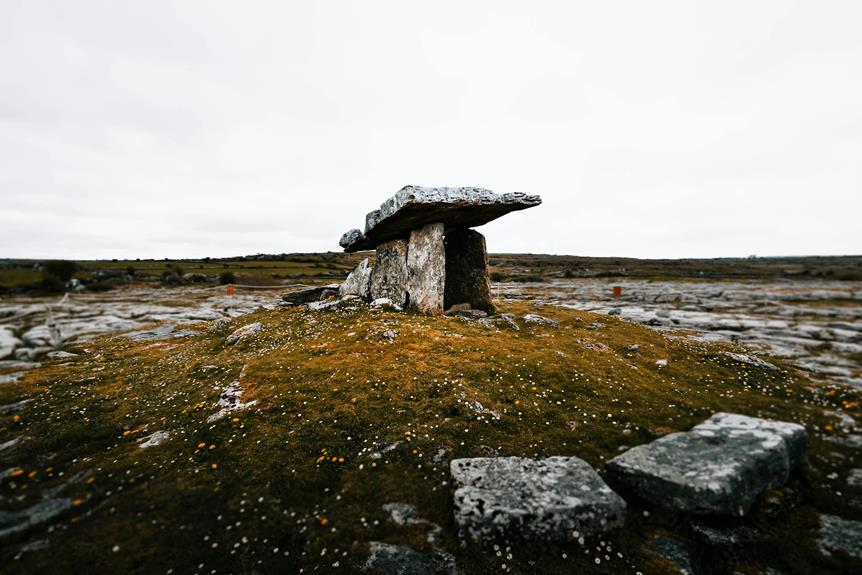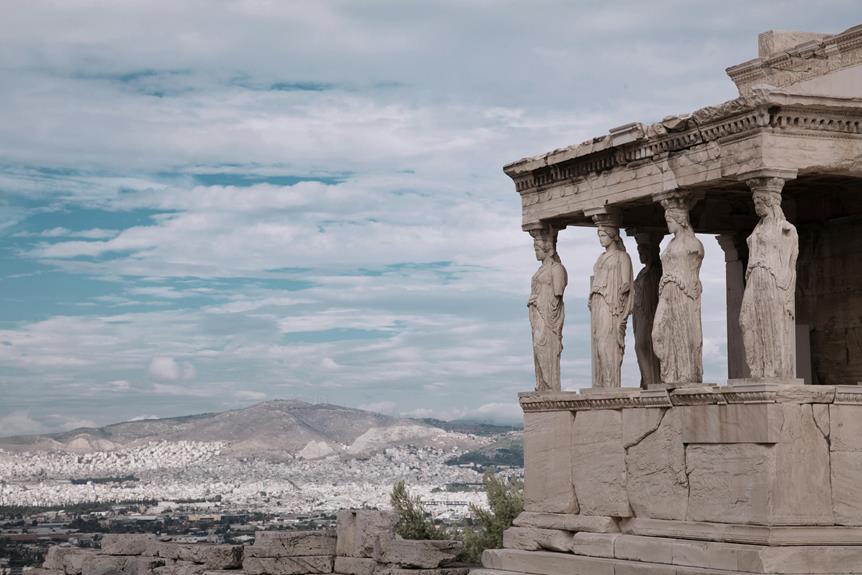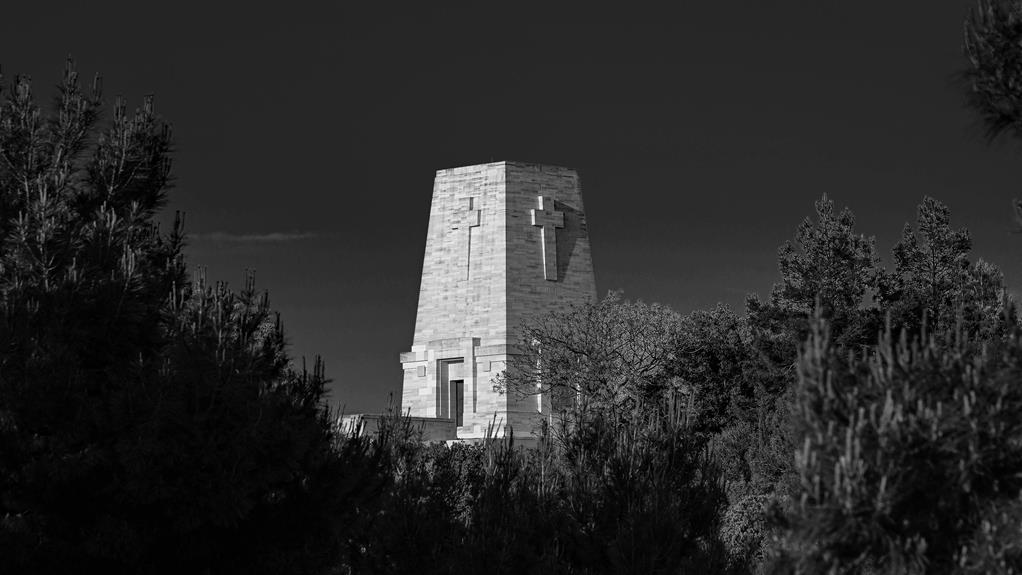Nestled near the infamous Mount Vesuvius, Herculaneum emerges as a fascinating archaeological site steeped in the remnants of a bygone era. The city's tragic fate, frozen in time by the catastrophic eruption, reveals a narrative of opulence and tragedy waiting to be explored. The meticulous preservation efforts have unearthed a trove of artifacts and insights into the daily lives of its ancient inhabitants. As we peel back the layers of history in Herculaneum, a complex tapestry of Roman civilization unfolds, promising a journey of discovery that transcends time.
Key Takeaways
- Ancient Roman city near Pompeii, preserved by Vesuvius eruption
- Rich archaeological site with well-preserved buildings and artifacts
- Offers insights into Roman daily life, art, and architecture
- Challenges in preservation due to delicate materials and exposure
- Important to balance tourism with conservation efforts
History of Herculaneum
Herculaneum, a coastal town in Italy, boasts a rich and complex history that dates back to ancient times. The influence of Herculaneum, particularly in the ancient world, was significant. As a prosperous city located near Naples, it served as a hub for trade and culture. The archaeological discoveries at Herculaneum have provided invaluable insights into the daily life, architecture, and art of the ancient Roman world.
Excavations at Herculaneum have unearthed well-preserved buildings, artifacts, and even human remains, frozen in time by the eruption of Mount Vesuvius in 79 AD. The Villa of the Papyri, a luxurious Roman villa, stands out as one of the most remarkable discoveries. Its extensive library collection, containing philosophical texts and works of ancient literature, has greatly expanded our understanding of intellectual life in the Roman Empire.
Moreover, the intricate frescoes and mosaics found in Herculaneum offer a glimpse into the artistic achievements of the time. The Villa of the Mysteries, known for its vivid and enigmatic frescoes depicting a mysterious religious rite, showcases the skill and creativity of ancient Roman artists.
Excavation and Preservation Efforts
The ongoing excavation and preservation efforts at Herculaneum play a pivotal role in uncovering and safeguarding the invaluable historical and cultural treasures buried beneath the layers of volcanic ash. These preservation techniques are essential for ensuring that the ancient city's legacy is protected for future generations. However, the process is not without its challenges. Excavation at Herculaneum faces numerous obstacles, from delicate structures at risk of collapse to the need for meticulous care to avoid damaging the fragile artifacts within.
To highlight the importance of preservation techniques and the challenges faced during excavation, the table below provides a concise overview:
| Preservation Techniques | Excavation Challenges |
|---|---|
| Consolidation of Structures | Structural Stability |
| Documentation of Artifacts | Preservation of Frescoes |
| Environmental Monitoring | Uncovering Fragile Objects |
| Restoration of Artifacts | Ensuring Historical Accuracy |
Preservation techniques such as consolidating structures and documenting artifacts are vital for maintaining the integrity of Herculaneum's ruins. However, excavation teams must navigate challenges like preserving delicate frescoes and ensuring the stability of uncovered structures. Environmental monitoring is also essential to protect artifacts from decay. By employing a combination of advanced preservation methods and addressing excavation challenges thoughtfully, Herculaneum can continue to reveal its secrets while safeguarding its cultural heritage.
Architectural Highlights
Architectural highlights in Herculaneum showcase a vital blend of ancient Roman design principles and innovative structural elements. The meticulous architectural design of buildings in Herculaneum reflects the sophisticated urban planning of the ancient city. The houses, characterized by their atriums, peristyles, and frescoed walls, offer insights into the daily life and social structure of the residents.
Construction techniques employed in Herculaneum played an essential role in the durability of the structures. The use of volcanic stone, known as tuff, in combination with brick and concrete, allowed for sturdy buildings resistant to the test of time. The intricate network of water pipes and sewage systems integrated within the architecture highlights the advanced engineering skills of the ancient Romans. These construction methods not only provided structural integrity but also contributed to the overall functionality of the buildings.
The architectural design of public spaces such as the Forum and the Baths of the Seven Sages further exemplifies the grandeur and sophistication of Herculaneum. The meticulous layout of streets, arches, and columns demonstrates a deep understanding of aesthetics and functionality. The preservation of these architectural marvels offers a glimpse into the creativity and expertise of ancient Roman architects and engineers, making Herculaneum a treasure trove for architectural enthusiasts and historians alike.
Daily Life in Ancient Herculaneum
The well-preserved ruins of Herculaneum provide a rich tapestry of evidence portraying the intricacies of daily life in this ancient Roman city. Social customs in Herculaneum were deeply rooted in the traditional Roman way of life. The layout of the city, with its narrow streets and closely packed buildings, suggests a society that valued community and social interaction. The presence of public baths, taverns, and communal spaces indicates a culture that placed importance on socializing and leisure activities.
Economic activities were vibrant in Herculaneum, evident from the numerous shops, workshops, and marketplaces that have been unearthed. These spaces give insights into the daily economic transactions that took place in the city. Artisans specialized in various crafts such as pottery, metalwork, and woodworking, showcasing a diverse economy where skilled labor was highly valued.
The homes in Herculaneum also shed light on the daily lives of its inhabitants. The layout of the houses, with central courtyards and multiple rooms, reflects a focus on family life and privacy. Wall paintings and mosaics found in these homes offer glimpses into the tastes and preferences of the residents, providing clues about their social status and cultural inclinations.
Herculaneum's Unique Artifacts
Numerous unique artifacts unearthed from the ruins of Herculaneum provide valuable insights into the daily lives and cultural practices of its ancient inhabitants. These artifacts hold significant archaeological and historical value, shedding light on various aspects of life in Herculaneum before the catastrophic eruption of Mount Vesuvius in 79 AD.
The significance of these artifacts lies in their ability to offer a glimpse into the daily routines, social structures, and artistic expressions of the ancient Herculaneum residents. From household items like pottery, furniture, and tools to elaborate works of art such as sculptures and frescoes, each artifact contributes to painting a more detailed picture of the people who once inhabited this ancient city.
However, despite their importance, these artifacts face preservation challenges due to the delicate nature of the materials from which they are made, such as fragile ceramics or perishable organic substances. The excavation and subsequent exposure to the elements can further degrade these artifacts if not handled with care and precision. Preservation efforts, including advanced conservation techniques and controlled storage environments, are vital to safeguarding these invaluable remnants of Herculaneum's past for future generations to study and appreciate.
Exploring the City Layout
Careful examination of the archaeological remains at Herculaneum reveals a structured and interconnected city layout that provides valuable insights into the urban planning of this ancient settlement. The city streets of Herculaneum were laid out in a grid pattern, showcasing a well-thought-out design that emphasized order and efficiency in movement. The streets were narrow, with varying widths, and made of large, irregularly shaped stones, reflecting the engineering prowess of the time.
Residential neighborhoods in Herculaneum were intricately integrated into the city fabric. Houses were typically multi-story structures, often featuring beautiful frescoes, intricate mosaics, and well-preserved furniture. The layout of these neighborhoods indicated a clear distinction between public and private spaces, with central courtyards serving as communal areas for social interactions and household activities.
To explore further into the city layout of Herculaneum, let's investigate the following table that highlights key aspects of the urban planning:
| Aspect | Description | Importance |
|---|---|---|
| Grid Layout | Structured city streets in a grid pattern for organized movement | Efficient urban planning |
| Multi-Story Houses | Residential structures with multiple floors, showcasing wealth and societal structure | Social hierarchy representation |
| Central Courtyards | Communal spaces within residential areas for social interactions and daily activities | Community building |
The layout of Herculaneum reflects a well-organized and thoughtfully planned ancient city that offers a glimpse into the daily lives of its inhabitants.
The Tragic Eruption of Vesuvius
Upon the eruption of Mount Vesuvius in 79 AD, the ancient city of Herculaneum faced a catastrophic event that forever altered its landscape and inhabitants' lives. The volcanic disaster buried the city under a thick layer of volcanic ash, mud, and debris, preserving it for centuries and providing unparalleled archaeological significance. The tragedy of Vesuvius's eruption was particularly devastating for Herculaneum, as the city was located closer to the volcano compared to its more famous neighbor, Pompeii.
The essential efforts at Herculaneum have been pivotal in uncovering the daily life and customs of its ancient residents. The layers of volcanic material that covered the city acted as a protective shield, safeguarding buildings, artifacts, and even organic materials like wooden furniture and food remains. Excavations at Herculaneum have revealed intricate details of Roman urban planning, architecture, and artistry, offering a glimpse into the past with remarkable clarity.
Despite the preservation of Herculaneum, the tragic events of 79 AD resulted in the loss of countless lives and the destruction of a thriving city. The ongoing excavations and preservation work at Herculaneum continue to shed light on the ancient world and the impact of natural disasters on human settlements. The story of Herculaneum serves as a poignant reminder of the fragility of civilization in the face of natural calamities.
Comparing Herculaneum and Pompeii
In examining the archaeological remains and historical significance of Herculaneum and Pompeii, notable similarities and differences emerge that offer valuable insights into the ancient Roman cities' lifestyles and fates.
- Urban Planning
- Both Herculaneum and Pompeii were well-planned Roman cities with sophisticated infrastructure, including paved streets, drainage systems, and public buildings.
- Pompeii had a grid-like street layout, while Herculaneum's streets followed the natural contours of the land, reflecting different planning approaches.
- Cultural Differences
- Herculaneum was a wealthier town compared to Pompeii, with evidence of more luxurious villas and better-preserved frescoes and mosaics.
- Pompeii, being larger and more commercial, had a more diverse population and a thriving economy with numerous shops and businesses.
- Architectural Variances
- Herculaneum had multi-story residential buildings, showcasing the wealth and social status of its inhabitants, while Pompeii had more single-story structures.
- The architectural styles in Herculaneum were influenced by Greek aesthetics, whereas Pompeii exhibited more Roman architectural features.
- Preservation Methods
- Herculaneum was buried under a deep layer of volcanic mud, which led to exceptional preservation of organic materials like wood, doors, and even food.
- Pompeii, on the other hand, was covered in ash and pumice, resulting in different preservation challenges and outcomes.
- Tourism and Research
- Pompeii attracts a larger number of visitors annually and has been subject to more extensive excavations and research projects compared to Herculaneum.
Tips for Visiting Herculaneum
When planning a visit to Herculaneum, it is important to take into account key aspects that will enhance your experience exploring this ancient Roman archaeological site. Initially, packing essentials such as comfortable walking shoes, a hat, sunscreen, and water are essential due to the extensive walking and exposed areas within the ruins. Additionally, consider bringing a map or guidebook to navigate the site effectively.
In terms of transportation options, reaching Herculaneum is convenient via train from Naples or Sorrento. Once you arrive at the Ercolano Scavi station, the archaeological site is just a short walk away, making it easily accessible for visitors.
Exploring the local cuisine is a must-do while visiting Herculaneum. Indulge in authentic Italian dishes at nearby restaurants like Osteria da Peppino or Il Piazzale. These establishments offer a taste of traditional Neapolitan flavors, providing a delightful culinary experience after a day of sightseeing.
For a more immersive experience, consider joining a guided tour to gain in-depth knowledge about the history and significance of Herculaneum. Local guides can offer fascinating insights into the daily life of ancient Romans and the tragic eruption of Mount Vesuvius that buried the city.
Future of Herculaneum's Archaeological Site
With ongoing preservation efforts and strategic planning, the future of Herculaneum's archaeological site holds promising prospects for continued exploration and historical understanding. The site faces several conservation challenges due to its delicate state and exposure to weathering over time. However, with advancements in conservation techniques and technologies, there is hope for mitigating these challenges and ensuring the site's longevity.
Additionally, the impact of tourism on Herculaneum is a double-edged sword. While tourism brings much-needed revenue for site maintenance and public awareness, it also poses a threat to the preservation of the ancient structures and artifacts.
- Conservation Challenges:
- Implementing advanced preservation techniques to protect fragile structures.
- Developing sustainable strategies for long-term conservation efforts.
- Balancing conservation needs with public access and tourism demands.
- Tourism Impact:
- Managing visitor numbers to prevent overcrowding and damage to the site.
- Educating tourists on the importance of responsible tourism and preservation.
Frequently Asked Questions
What Were the Main Industries in Ancient Herculaneum?
Ancient trades in various regions were essential economic activities that sustained societies. These included agriculture, pottery, metalworking, textiles, and fishing.
Industrial sectors were diverse, involving skilled craftsmen and laborers. Workforce dynamics were influenced by the specialization of labor and the development of trade networks.
These activities supported the local economy, facilitated cultural exchange, and contributed to the overall prosperity of ancient civilizations.
How Did the Eruption of Vesuvius Impact Nearby Cities?
The eruption of Vesuvius had far-reaching consequences on nearby cities, impacting them economically and culturally. The economic impact was profound, disrupting trade routes and causing widespread devastation to industries.
However, this catastrophic event inadvertently led to the preservation of ancient artifacts and structures, providing valuable insights through archaeological findings. Today, these cities attract modern tourism, offering a glimpse into the past while showcasing the resilience of their inhabitants amidst natural disasters.
Are There Any Hidden Tunnels or Secret Passageways in Herculaneum?
Hidden chambers and underground networks have long fascinated explorers and historians alike. Such passageways often serve as intriguing elements in historical narratives, adding layers of mystery and complexity to the structures they are found within.
The presence of secret tunnels can offer valuable insights into the architectural ingenuity and strategic planning of past civilizations. Exploring these hidden spaces can reveal untold stories and shed light on the daily lives of ancient inhabitants.
What Types of Food Were Commonly Eaten in Ancient Herculaneum?
Ancient recipes provide insight into culinary traditions of the past, showcasing a variety of foods commonly eaten in different regions. These recipes offer a glimpse into the ingredients, cooking methods, and flavors prevalent in ancient societies.
Is There Any Evidence of Ancient Religious Practices Found in Herculaneum?
Is there evidence of ancient religious practices in this location?
The study of ancient rituals through archaeological discoveries sheds light on the spiritual beliefs and practices of past civilizations. By examining artifacts, inscriptions, and structures, researchers can uncover clues about ceremonies, deities worshipped, and religious customs.
These findings provide valuable insights into the cultural and social aspects of ancient societies, enriching our understanding of their spiritual world.
Conclusion
To summarize, Herculaneum, Italy, stands as a remarkable demonstration of the advanced engineering skills and vibrant social customs of ancient Roman civilization.
Through meticulous excavation and preservation efforts, the city's architectural highlights, daily life insights, and unique artifacts offer valuable glimpses into the past.
Despite the tragic eruption of Vesuvius, Herculaneum's rich history continues to captivate visitors and researchers alike, promising a future of continued exploration and discovery.


